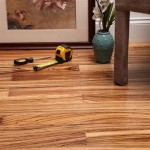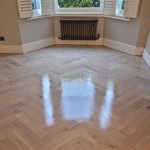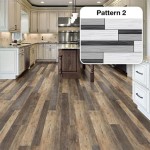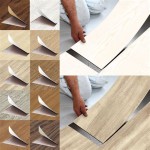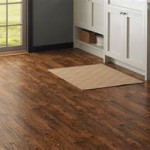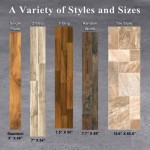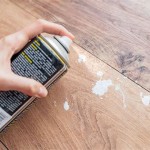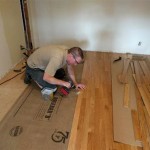How To Remove Tape Residue From Floors
Tape residue on floors is a common annoyance encountered in both residential and commercial settings. It can result from various taping applications, including securing carpets, marking boundaries, protecting surfaces during painting, or simply from prolonged use of adhesive tapes that degrade over time. Regardless of the source, this residue can create a sticky, unsightly mess that attracts dirt and is difficult to remove with standard cleaning methods. The persistence of tape residue stems from the nature of adhesives; they are designed to bond strongly, often leaving behind a tenacious layer when the tape is removed. This article will outline several effective strategies and techniques for removing tape residue from various types of flooring surfaces, emphasizing safety and the preservation of the floor's integrity.
The approach to removing tape residue from floors depends heavily on the type of flooring material. What works effectively on a ceramic tile floor might damage a delicate hardwood surface. Therefore, identifying the specific floor type--be it hardwood, laminate, vinyl, tile, concrete, or carpet--is crucial before selecting a cleaning method. Performing a spot test in an inconspicuous area before applying any cleaning solution to the entire affected area is also always advisable. This preliminary step helps determine if the solution will discolor or damage the flooring.
Identifying the Type of Tape Residue
Before attempting to remove tape residue, it's beneficial to assess the nature of the residue itself. Some tapes leave behind a soft, gummy adhesive, while others create a hardened, crusty layer. The type of residue will influence the choice of removal methods. For instance, a soft residue might respond well to solvents like rubbing alcohol or adhesive removers, while a hardened residue might require more abrasive techniques, potentially involving scraping or heat application.
Furthermore, consider the age of the residue. Fresh residue is generally easier to remove than residue that has been allowed to cure and harden over extended periods. Older residue tends to bond more strongly with the flooring material, making removal more challenging and possibly requiring multiple treatments.
Effective Removal Methods
A range of methods can be employed to remove tape residue, from simple household solutions to specialized cleaning products. The selection of the most appropriate method should be based on the type of flooring, the nature of the residue, and the level of sensitivity required to avoid damaging the floor's surface.
Warm Water and Dish Soap: This is often the first and gentlest approach. Mix a small amount of mild dish soap with warm water. Apply the solution to the residue, allowing it to soak for several minutes to soften the adhesive. Then, use a soft cloth or sponge to gently scrub the area. Rinse with clean water and dry thoroughly. This method is suitable for most floor types, especially those with delicate surfaces.
Rubbing Alcohol (Isopropyl Alcohol): Rubbing alcohol is an effective solvent for many types of adhesives. Apply rubbing alcohol to a clean cloth and gently blot the residue. Allow the alcohol to dwell on the residue for a few minutes to dissolve the adhesive. Wipe away the residue with the cloth, using a fresh area of the cloth as needed. This method is generally safe for most hard flooring surfaces, but a spot test is still recommended, particularly on painted or finished wood floors.
Vinegar: Vinegar, specifically white vinegar, is a natural cleaning agent that can help dissolve tape residue. Heat a small amount of vinegar in the microwave until it is warm, but not boiling. Apply the warm vinegar to the residue, allowing it to soak for several minutes. Scrub with a soft cloth or sponge. Rinse with clean water and dry. Vinegar's acidity can damage certain types of flooring, particularly natural stone, so caution and spot testing are essential.
Baking Soda Paste: Baking soda is a mild abrasive that can help lift tape residue. Mix baking soda with water to form a thick paste. Apply the paste to the residue and allow it to sit for several minutes. Gently scrub the area with a soft cloth or sponge. Rinse with clean water and dry thoroughly. Baking soda is generally safe for most floor types, but it should be used with caution on soft or easily scratched surfaces.
Oil-Based Solutions: Oils can help break down the adhesive bond in tape residue. Vegetable oil, mineral oil, or even peanut butter can be applied to the residue and allowed to sit for several minutes. Wipe away the oil and residue with a clean cloth. This method is effective for removing sticky residue, but it can leave an oily residue behind. Clean the area with dish soap and water after removing the tape residue.
Adhesive Removers: Commercial adhesive removers are specifically designed to dissolve tape residue. These products typically contain solvents that effectively break down the adhesive bond. Follow the manufacturer's instructions carefully when using these products. Ensure adequate ventilation and wear appropriate protective gear, such as gloves. Always test the adhesive remover in an inconspicuous area before applying it to the entire affected area.
Heat Application: Applying heat can soften the tape residue, making it easier to remove. A hairdryer can be used to gently heat the residue. Hold the hairdryer a few inches away from the floor and move it back and forth to avoid overheating the area. After heating, try wiping away the residue with a soft cloth or scraping it off with a plastic scraper. This method is particularly effective for removing hardened residue.
Tools and Techniques for Residue Removal
The effectiveness of any removal method is enhanced by the appropriate use of tools and techniques. Using the right tools not only facilitates the removal process but also minimizes the risk of damaging the flooring.
Plastic Scrapers: Plastic scrapers are ideal for removing tape residue without scratching the flooring surface. Use a scraper with a flat, smooth edge. Gently slide the scraper under the edge of the residue and lift it away from the floor. Avoid applying excessive pressure, which could damage the floor.
Soft Cloths and Sponges: Soft cloths and sponges are essential for applying cleaning solutions and wiping away residue. Use cloths made of microfiber, as they are gentle and absorbent. Avoid using abrasive scrub pads, which can scratch the floor.
Toothbrushes: An old toothbrush can be useful for scrubbing residue in hard-to-reach areas or on textured surfaces. Use a soft-bristled toothbrush to avoid scratching the floor.
Steam Cleaners: Steam cleaners can be used to loosen tape residue. The heat and moisture from the steam can soften the adhesive, making it easier to wipe away. Ensure that the flooring material is compatible with steam cleaning before using this method. Steam cleaning is effective on tile and some types of vinyl flooring, but it should be avoided on hardwood floors.
Razor Blades (with extreme caution): In cases of particularly stubborn residue, a razor blade might be considered. However, razor blades should be used with extreme caution and only by individuals experienced in their safe handling. Hold the razor blade at a low angle to the floor and gently scrape the residue away. Avoid applying excessive pressure, and always use a new blade to minimize the risk of scratching the floor. This method is generally safe on glass or ceramic tile, but not recommended on wood, laminate or vinyl.
Floor-Specific Considerations
Different flooring materials require specific approaches to tape residue removal to prevent damage. The following outlines considerations for various common flooring types:
Hardwood Floors: Hardwood floors are susceptible to scratching and water damage. Avoid using abrasive cleaners or excessive amounts of water. Use gentle methods like warm water and dish soap or rubbing alcohol, and always dry the floor thoroughly after cleaning.
Laminate Floors: Laminate floors are also prone to water damage. Avoid using excessive amounts of water and harsh chemicals. Use a mild cleaning solution and a soft cloth to wipe away the residue. Ensure that the floor is completely dry after cleaning.
Vinyl Floors: Vinyl floors are generally more durable than hardwood or laminate. However, they can still be damaged by abrasive cleaners or solvents. Use warm water and dish soap or vinegar to remove tape residue. Avoid using harsh chemicals or abrasive scrub pads.
Tile Floors: Tile floors are relatively resistant to damage from cleaning agents. Use warm water and dish soap, vinegar, or commercial tile cleaners to remove tape residue. A scrub brush can be used to scrub the residue in the grout lines.
Concrete Floors: Concrete floors are durable but can be porous. Use warm water and dish soap, vinegar, or commercial concrete cleaners to remove tape residue. A scrub brush can be used to scrub the residue. Seal the concrete floor after cleaning to prevent future staining.
Carpeted Floors: Removing tape residue from carpets requires a different approach. First, try to peel away as much of the tape as possible. Then, use a carpet cleaner or a solution of warm water and dish soap to blot the residue. Blot the area with a clean cloth until the residue is removed. Avoid rubbing the carpet, as this can damage the fibers.
By carefully selecting the appropriate removal method, utilizing the right tools, and considering the specific characteristics of the flooring material, the task of removing tape residue from floors can be accomplished safely and effectively. Regular maintenance and prompt attention to residue buildup can help prevent the adhesive from becoming deeply ingrained and more difficult to remove over time.

The Best Way To Remove Tape Residue From Hardwood Flooring Between Naps On Porch

The Best Way To Remove Tape Residue From Hardwood Flooring Between Naps On Porch

Struggling To Remove Sticky Adhesive Tape In Singapore Here S How Do It Right

Best Cleaner Ever To Remove Sticky Tape From Floors Etc Safe Easy

4 Ways To Remove Adhesive From A Hardwood Floor Wikihow

How To Remove Tape Residue Duct

How To Quickly And Easily Remove Tape Residue Stylus Tapes International

The Best Way To Remove Tape Residue From Hardwood Flooring Between Naps On Porch

How To Remove Adhesive Tape Residue

Easy Ways To Get Rid Of Carpet Tape On Wooden Floors Or Stairs Floor Sanding
See Also
